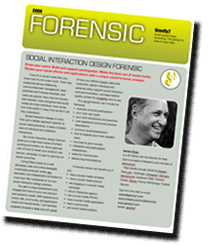The SIM score is apparently a social media version of the Net Promoter mode. Adage puts it like this: "How likely is it that you would recommend our company to a friend or colleague?" (To get the score, subtract the "highly likelies," or promoters, from the "unlikelies," or detractors.)
And according to the article, the Razorfish SIM score seeks to capture the strength of social media as a medium for organically surfacing recommendations. Quoted in Adage, Shiv Singh, VP-global social media lead at Razorfish also recognizes what many social media marketers have long known: the conversation is out there (like it or not):
"Any mention of a brand, as long as it's not negative, serves a brand-awareness purpose on the web because once it's there, it stays there."
The score comprises of a net measure of sentiment as captured in social media mentions. Again, from Adage:
Razorfish worked with TNS/Cymfony to capture social media content and the net sentiment of a brand: the positive and neutral conversations minus negative ones, divided by total conversations about the brand.
As most folks in the social media analytics space know, as I'm sure is familiar at Razorfish and Cymfony, social media do not make it easy to obtain sentiment and semantic metrics. There are several reasons for this, some of which are specific to the medium and some of which are behavioral:
- The 140 character limit on tweets puts significant pressure on context. Context is often left out of tweets where it can be assumed by the reader. Crawlers of course have difficulty recognizing the implicit references and context of tweets, so some if not many tweets are simply missed.
- Expressions in twitter are colloquial, if not also abbreviated, shortened, and clipped. Again, expressions often don't explicitly reference topics and content (brands, industries, products included).
- People make recommendations in twitter shaped in part by who they follow and who's following them. One can't remove the act of recommending from the audience the recommendation is made to or in front of. People will often make recommendations not only to share their feelings about a product/brand, but also to publicly identify with that product or brand. References made in social media like twitter reflect on the twitterer. Tweets can show a person identifying with something or someone, attracting the attention of someone, showing gratitude to someone, showing affection for someone, and so on.
- In public social media like twitter, a recommendation may also serve the purpose of building a person's credibility or reputation as an expert, influencer, trusted authority, and so on. Consider the difference in recommendations made by @Scobleizer and @GuyKawasaki and @jowyang. Each of these heavy users and influencers has his own way of watching for, filtering, selecting and then tweeting or retweeting. @guykawasaki has influence as a newswire, more than @jowyang, whose influence rests more on his personal and professional authority.
- Recommendations can come as answers to solicited or unsolicited requests for help or information.
- Recommendations may be made as a means of introduction on twitter -- sometimes to get followed back, to get noticed, or simply to be helpful.
These are some of the ways in which recommendations might be distinguished in social media from recommendations made face to face or by other means (as measured by the Net Promoter method). In conversational media, the act of communicating is difficult to separate from the information communicated. Recommendations and the act of recommending can be measured differently, and have different meanings: the intention behind the act, the message or information provided, motives inferred by recipient to the act. (Person A tells person B to go see Harry Potter, hoping to get the question "Oh you saw it?! Was it good?" and instead Person B ignores Person A, wondering to herself "Why is A telling me to see Harry Potter? Don't they know it's not my kind of thing?")
There are also ways in which recommendations may elude attempts to simplify sentiment captured from social media. There are also ways in which social media provide information about a brand's "influence" that are not in what people say but in how they say it, to whom, and what happens when they do. Some of this is what we can call "envelope" information (tweet addressing: to whom, for whom, citing whom, or @name, @reply, RT).
The rest of it is in the distribution: reach, volume, velocity, acceleration. These are aspects of flow and are among the attributes captured by some social media analytics tools. In marketing speak:
- How quickly is brand retweeted?
- Who retweets?
- How deep down a social graph does the retweeting go?
- How far across a social network does the retweeting go?
- and so on
I know that these aspects of social media activity are difficult to track and measure. But it would be great if there were an industry-wide effort to define and codify some of the attributes of social networks, relationship-based communications, and common types of expression in order to better represent conversational activity in social media. The results would not only paint a more accurate picture of brand presence in social media, but would also match the real social mechanics and dynamcis of online conversations. It may take a while for algorithms and tools to emerge for this. In the meantime, I would supplement SIM scoring with insight from a good community manager.
Labels: influence, social media marketing, social media metrics




Comments: :
blog comments powered by Disqus
<< Home